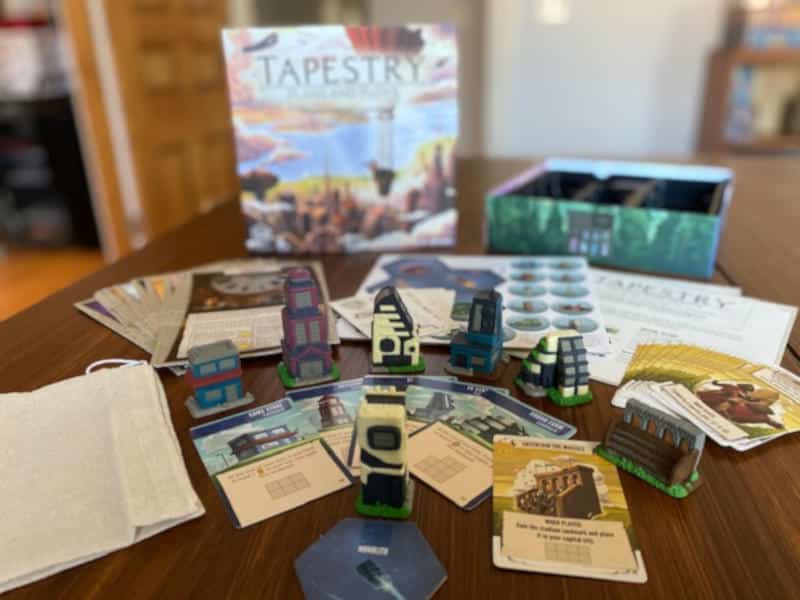I love Hegemony: Lead Your Class to Victory. It’s an amazing economic simulation with huge ambitions. And yet, it rarely comes to the table. The reason is simple. It takes about half an hour to set up. You have to separate card decks, shuffle them, put a number of different components into different locations and do various other things before you can start playing. While Hegemony is a heavy game, it’s not its complexity that is the problem. It’s the effort of setting it up. That made me think about whether a critical board game review should consider this or if this is more the remit of a product review.
Listen to the Audio Version
Intro Music: Bomber (Sting) by Riot (https://www.
Success by Mixaund | https://mixaund.
Music promoted by https://www.
Music by: Bensound
License code: XYJHH24GPPT8BJ8G
Artist: : Benjamin Tissot
Music by: bensound.com
License code: H45DI1U3YDTYLGF5
Artist: : Lunar Years
Music I Use: https://www.
License code: ZX5IAGTXWISS2AEZ
Artist: : Aventure
Music by: https://www.
License code: DMMTAKZV5MTBQDPI
Artist: : Yunior Arronte
Beyond the Box Lid
Let me start by explaining what I mean by a critical review and a product review, because they are different and that distinction is very important.
A product review describes what is in the box, how well the game is made, and whether it offers value for money. It focuses on specifications, materials, and overall usability. For example, Stonemaier Games is known for making high-quality games when you look at them as products. Cards have a linen finish, and games have custom wooden components.
A critical review, on the other hand, looks at board games more as cultural artefacts. It considers what kind of experience it creates through play. The designer’s intent should be considered in a critical review, and it should focus on how the whole game operates as a designed experience. As a result, critical board game reviews are reflective and contextual.
For example, short rulebooks for complex games or long rulebooks for straightforward games aren’t in themselves bad. What matters is whether they help players learn the game. While a rulebook’s word count has no place in a critical review, when a rulebook confuses players, it needs to be mentioned
Similarly, beautiful art and detailed illustrations are no better or worse than very functional graphic designs, until you look at how they interact with the gameplay experience. When the art interferes with how playable a game is, it deserves critical attention.
In Fled, for example, the detailed illustrations create mood and atmosphere, but they interfere with seeing key information. Icons become difficult to read, especially from across the table. This creates a conflict between the game’s aesthetic goals and its functional needs. A critical review does not highlight this as a printing error. It highlights it as a design issue that negatively affects the gameplay experience.

Get yourself a wooden Tabletop Games Blog dice tray.
Each tray is the perfect size to roll your dice, and with the soft mat, it’s really quiet, while the wooden frame makes it wonderfully sturdy.

Friction in Board Games
Let’s look at other things that might feel like they belong in a product review, but not a critical board game review.
Some games have intentionally been designed to include friction, such as restricted actions or delayed consequences. It can introduce tension, create pacing, and limit decision-making. However, when a game rubs players up the wrong way that wasn’t intentionally designed to be part of the gameplay experience, it’s a problem that needs to be investigated in a critical review.
Hegemony contains both types of friction. Its ideological asymmetry and strategic depth are heightened by a slow burn of economic and political decision-making. It can feel frustrating when you can’t do the things you want to do, but this friction is by design.
However, the thirty-minute setup introduces unintended friction. It delays engagement, drains enthusiasm, and can prevent the game from being played at all. Long setup time does not contribute to the theme of the game or pose a challenge that players would relish. It merely stands in the way.
A critical review must recognise that setup and teardown are part of a board game’s experience. If they affect who chooses to play, or how often a game gets played, they directly affect gameplay experience, which makes them worth discussing.
Additionally, anything that slows down the actual playing of a game is also important to consider in a critical board game review.
For example, in Mystic Vale, sliding cards you buy during the game into their transparent card sleeves takes time. Mechanically, this supports the game’s theme. Physically, however, it creates problems. Sleeving cards during play is fiddly and slow. That affects not only the tempo of individual turns but also the desire to play again. On top of that, it affects setup or teardown, which takes additional time.
Detail Distraction
Deciding what to include in a critical review, which may normally fit better into a product review, isn’t easy. It would be easy to talk about every warped game board, every flimsy card stock, every badly die-cut punchboard, or every off-centre printout.
However, critical board game reviews only select what actually matters. Not all flaws deserve equal attention. The significance of a detail depends on its impact on the gameplay experience. A badly printed card back only matters if your hand of cards is supposed to be a secret. If all cards are public information, it’s not really an issue.
Product reviews, on the other hand, often treat all features equally. Everything receives a rating, a mention, or a sentence. Product reviews can even go as far as talking about cardstock weight in gsm, the quality of UV spot varnishes, or the durability of wooden tokens versus cardboard ones. Those are important factors to consider if you look at a game as a product that you spend your money on.
Critical board game reviews, on the other hand, tell you how much enjoyment you’re going to get for your money. They can help you decide the money per hour ratio, even though many critical reviews don’t list game prices. However, if you can see from a review whether a game is for you and how much time you’re likely going to invest in it, you can decide for yourself whether you’re happy to buy a brand new copy of the game or hold out for a second-hand one or maybe wait for a retailer’s sale.

Digital Distinction
Given what I’ve said so far, it will be clear why a critical review of a digital version of a board game is going to be significantly different to one of a physical copy. In digital board games, most housekeeping tasks, such as setup, card shuffling, or moving tokens, are handled automatically. As a result, the digital version of a game often feels more streamlined, more accessible, and sometimes even more elegant.
A game that feels heavy or tiresome in person may become fluid and focused online. Long setup fades into a loading screen. Slippery cards are replaced by responsive interfaces. Every choice becomes immediate, not delayed by manual tasks. So while the game itself is the same, the gameplay experience is definitely different.
A critical review of a digital board game must consider these differences. The review cannot assume that digital and physical games are equivalent. What changes in digital play must be evaluated carefully. Automation removes friction, but that friction may have been part of the experience. Critical reviewing means noticing when that absence alters the meaning of play.
While most of my reviews are of physical games, I do review digital games. However, I point this out in the review. It needs to be clear that I was unable to consider how the setup, components and everything else affect the gameplay experience. It also needs to be understood that the review doesn’t cover the face-to-face interactions that a physical game offers. The review will mostly focus on the gameplay itself and therefore will likely put a heavier weighting on mechanisms and visual presentation.
Boundaries and Bridges
Critical and product reviews serve different purposes. One focuses on helping people decide what they get. The other focuses on helping people understand what the gameplay experience is like. The tools overlap, but the intent does not. A critical review can mention components or production quality, but only when those features affect gameplay.
After all, board games are not just boxes with components in them. They are interactive and shared experiences. Critics must resist the urge to rate isolated parts and instead look at how the game functions as a whole. When a mechanism breaks the flow, or when a production choice breaks the theme, that is not a small matter. It is an important flaw that can negatively impact the gameplay experience.
A critical review will look at all of these things together and weigh up what needs to be mentioned and what can be glossed over. At least I hope that’s what I achieve with my board game reviews and that’s what I strive for.
If you enjoyed this article, please have a look at my support page to see how you can help keep the blog going.
Useful Links
- Stonemaier Games: https://stonemaiergames.
com/ - Fled review: https://tabletopgamesblog.
com/ 2025/ 07/ 26/ fled-saturday-review/ - Mystic Vale review: https://tabletopgamesblog.
com/ 2018/ 12/ 08/ mystic-vale/
Audio Version
Intro Music: Bomber (Sting) by Riot (https://www.
Success by Mixaund | https://mixaund.
Music promoted by https://www.
Music by: Bensound
License code: XYJHH24GPPT8BJ8G
Artist: : Benjamin Tissot
Music by: bensound.com
License code: H45DI1U3YDTYLGF5
Artist: : Lunar Years
Music I Use: https://www.
License code: ZX5IAGTXWISS2AEZ
Artist: : Aventure
Music by: https://www.
License code: DMMTAKZV5MTBQDPI
Artist: : Yunior Arronte
Playlist
These are the songs I listened to while I was writing this topic discussion article:

